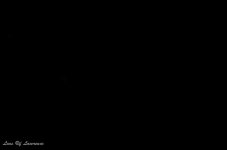I was playing with this yesterday but I found out that my d5300 doesn't have auto fp, and the max sync speed with built in flash is 1/200 so it makes this not possible, are there any other routes for it?
In my case essentially for portraits just to achieve the black background like you can see in arty macros etc?
But nobodies flash allows more than 1/200 or 1/250 second shutter speed, so that is no issue at all. You're not trying hard enough.

It is not hard. A black background generally only depends on these factors:
1. Background sufficiently far back to not be illuminated by the flash added to the foreground. Talking maybe subject at 3 feet and background at maybe 9 feet (3x farther than subject). It helps of course if the background is black, but not required, reduced lighting can make any color look black. Flash falls off with distance, 3x distance is pretty dark back there. 4x is better.
Really the idea is that a moving the subject closer to the light makes the same background relatively more distant from that light .... the difference between them.
2. Ambient light sufficiently low so as to Not illuminate the background well enough to be seen. That does NOT mean dark, it just means normal indoor lighting, but Not bright. A white background with no light on it looks black. What helps this greatly is low ISO and stopped down aperture and 1/200 second, to make the ambient light low for the photo ... yet the flash uses enough flash power to overcome it and still have strong effect.
Example, regular studio flash taking regular studio portraits probably uses ISO 100 (a low value) and maybe f/8 (a high value). The main light is probably only about 3 feet from the subject (close is better to create a relatively distant background - also makes the main light appear bigger and softer). The main light probably has a strong incandescent modeling light in it. Yet, even with normal indoor room lighting, ISO 100 and 1/200 second at f/8 is a BLACK picture, with modeling light on the near subject, but without the flash. The modeling light looks bright, and it is a strong orange, but it needs more than ISO 100 1/200 f/8. It does not even show up. The background is black too (without the flash). And the flash at 3 feet lights the subject, but does not reach to the background at say 9 feet (will be 3 stops down back there - and not necessarily even aimed that direction).
So... for a black background, just keep the light off of the background (don't aim main light straight back, instead angle it more sideways to then miss the visible background. If necessary, tape a card on the side of the flash to block and keep the light off of the background... called a barn door). And keep the background fairly far back. Do NOT use high ISO or wide aperture or low shutter speed, which would simply emphasize the ambient. De-emphasize the ambient with low ISO and stopped down aperture and 1/200 second. Use flash power to overcome that for the final near picture.
See this example.
45 degree Portrait Lighting Setup
See about 25% down the page there to the picture that says "Main Light Only". See the black background? See in the top pictures where the background is? The background needs its own light to show up and be visible. This is ISO 200 only because the D300 only goes down to 200. f/10 and 1/200 second.
Try things. If you need a little more, then do a little more.

